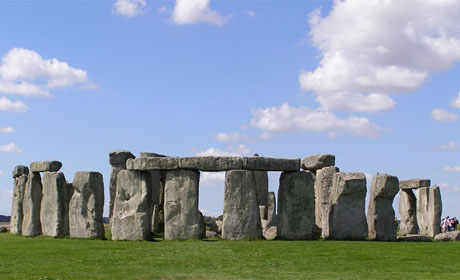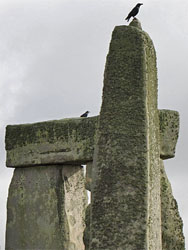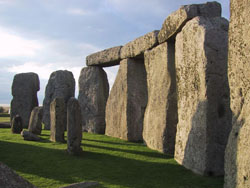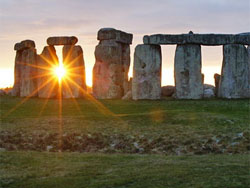Stonehenge
Wiltshire, England
 The People’s Choice
The People’s Choice
Stonehenge represents one of Britain’s most important and enigmatic archaeological sites. Beginning in Neolithic times and modified during the Bronze Age it currently comprises a number of incomplete stone circles and stone horseshoes, built in five constructional stages spanning a period from around 3000 to 1500 BC. During that time the form of the monument was reconfigured significantly and the bluestones rearranged on numerous occasions.
 The outer circle and the outer horseshoe are constructed of hard siliceous sandstones (most probably silcretes). These are the so-called ‘sarsen’ stones which are thought to have been derived relatively locally, most probably from the Marlborough Downs area of Wiltshire, around 30km to the north of Stonehenge. These are the larger stones at Stonehenge, weighting up to xx tones, and measuring up to xx m in height; they form the so-called ‘Trilithons’.
The outer circle and the outer horseshoe are constructed of hard siliceous sandstones (most probably silcretes). These are the so-called ‘sarsen’ stones which are thought to have been derived relatively locally, most probably from the Marlborough Downs area of Wiltshire, around 30km to the north of Stonehenge. These are the larger stones at Stonehenge, weighting up to xx tones, and measuring up to xx m in height; they form the so-called ‘Trilithons’.
The inner circle and the inner horseshoe comprise stones which as early as the late 19th Century were considered to be exotic to the region. These stones comprise the so-called ‘bluestones’, a term which is applied to all non-sarsen stones. The bluestone assemblage comprises a mix of igneous and sedimentary rocks typically weighing 2-3 tonnes, predominantly low-grade metamorphosed dolerites and rhyolitic tuffaceous rocks, but also strongly cleaved volcaniclastic rocks, as well as at least two different types of sandstone, one of which comprises the Devonian ‘Altar Stone’ sandstone.
 In a seminal paper published in the Antiquaries Journal in 1923, H.H. Thomas, an officer for the Geological Survey, announced that he had identified the sources of some of the Stonehenge bluestones in the Mynydd Preseli area of north Pembrokeshire, identifying Carn Meini and Cerrigmarchogion, Carn Alw and Foel Trigarn as sources for the dolerites, rhyolites and volcaniclastic rocks respectively.
In a seminal paper published in the Antiquaries Journal in 1923, H.H. Thomas, an officer for the Geological Survey, announced that he had identified the sources of some of the Stonehenge bluestones in the Mynydd Preseli area of north Pembrokeshire, identifying Carn Meini and Cerrigmarchogion, Carn Alw and Foel Trigarn as sources for the dolerites, rhyolites and volcaniclastic rocks respectively.
The provenance of these stones has led to great speculation as to how the stones were transported to Stonehenge, one of the vexed questions of British archaeology. There is still debate as to whether the bluestones were transported from north Pembrokeshire by ice or by humans, and if by humans how they were transported and by which route.
 Recent petrological and geochemical investigations have identified a new source for some of the rhyolitic bluestone material, currently only found as debris in the Stonehenge landscape. This is provenanced to a prominent rhyolite crag called Craig Rhos-y-felin, on low ground to the north of the Mynydd Preseli. In addition, Carn Goedog has recently been determined to be an important source for a significant proportion of the doleritic bluestones analysed to date.
Recent petrological and geochemical investigations have identified a new source for some of the rhyolitic bluestone material, currently only found as debris in the Stonehenge landscape. This is provenanced to a prominent rhyolite crag called Craig Rhos-y-felin, on low ground to the north of the Mynydd Preseli. In addition, Carn Goedog has recently been determined to be an important source for a significant proportion of the doleritic bluestones analysed to date.
Text courtesy of Richard Bevins, National Museum Wales
Watch the British Geological Survey's video to find out more about building stones: